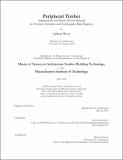Peripheral timber applications for waste wood material in extreme climates and earthquake risk regions
Author(s)
Brose, Andrew(Andrew John)
Download1125950442-MIT.pdf (10.92Mb)
Other Contributors
Massachusetts Institute of Technology. Department of Architecture.
Advisor
John Ochsendorf.
Terms of use
Metadata
Show full item recordAbstract
Worldwide, discarded construction and demolition material account for 40% of all municipal solid refuse including residential, commercial, institutional, and agricultural waste flows (Elgizawy, El-Haggar, and Nassar 2016). Hong Kong sends over 200 tons of timber waste from old formwork and scaffolding to the landfill per day (Wang et al. 2016). After fulfilling their assumed raison d'etre, the cement-flaked shuttering boards and stubby scaffolding poles arrive amongst the discards, eventually deformed beyond utility. This thesis explores the possibilities of reusing wood that sits at the fringe of construction projects, in applications that bring back the beauty and elegance ingrained in the oldest of building material. In part, this project is a remolding of the perception of undervalued wood species and construction waste. This research proposes specific techniques, inculcating value into discarded wood material and bringing a new mechanism for the material production of timber existing at the periphery of design and construction. In application, this study considers solutions around natural fiber composites and timber space-frame roofs for affordable housing projects. A prototype space-frame using small diameter wood elements was constructed in India and made practical by the development of a simple joint system. Load testing of the frame provided positive results (2.3 kN/m²) and surpassed India National Building Code standards for roof design. In addition, waste wood fibers incorporated in cementitious wall and roof panels improved thermal insulation properties (0.164 W/m²·K) while increasing flexural strength (4.6 N/mm²). Prototype and samples were tested within the objectives of improved thermal comfort, increased earthquake safety, and reduced material cost.
Description
This electronic version was submitted by the student author. The certified thesis is available in the Institute Archives and Special Collections. Thesis: S.M. in Architecture Studies: Building Technology, Massachusetts Institute of Technology, Department of Architecture, 2018 Cataloged from student-submitted PDF version of thesis. Includes bibliographical references (pages 63-66).
Date issued
2018Department
Massachusetts Institute of Technology. Department of ArchitecturePublisher
Massachusetts Institute of Technology
Keywords
Architecture.